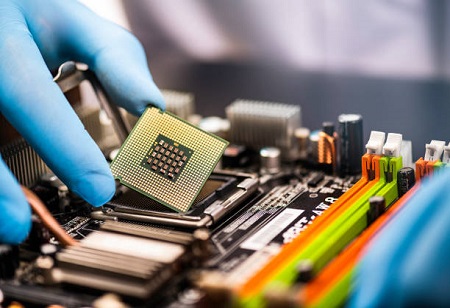
Driven by government support vast market as well as growing R&D spending in countries such as Japan, China, South Korea as well as Taiwan together have become some of the top semiconductor players in the Asia Pacific region, possessing as some of the top six spots by overall semiconductor revenue & each have several global semiconductor giants. Asia Pacific is also the biggest market in the world for semiconductors, that accounts for sixty per cent of global semiconductor sales. While the semiconductor value chain is both long & comprises several specialized fields that include equipment, intellectual property, integrated device manufacturer, outsourced semi-conductor assembly & test, electronic design automation software & foundry, each of the big players hold different strengths & play a crucial role in the global semiconductor value chain. Some of the top semiconductor manufacturing countries in Asia include:
- South Korea
- Japan
- Taiwan
South Korea – Leading the pack
The semiconductor sector in South Korea is large & it comprises several enterprises. The biggest semiconductor enterprises include Samsung & SK Hynix. The most important company in South Korea which conducts IC design, smart phones as well as wafer manufacturing is Samsung. SK Hynix has directed the world in DRAM as well as NAND Flash market share for several years. The country holds more than 20000 semiconductor related companies, which includes 369 IC manufacturing companies, 2650 semiconductor equipment enterprises & 4078 semiconductor material enterprises. Through layers of outsourcing as well as subcontracting, a huge semiconductor industry chain has been created in South Korea, a typical semiconductor factory is surrounded by a wide range of supporting firms. This has helped in forming city clusters of semiconductor industries, that are supporting the whole semiconductor industry of South Korea. The country has also surpassed Japan & Taiwan to become the 2nd largest semiconductor country after the US.
Japan – the only country capable of creating pure semiconductor materials
The strength of Japan in the semiconductor sector is present in the raw materials, equipment as well as small active-passive components. Coupled with the semiconductor value chain, the country has substantial advantages in upstream semiconductor materials. While semiconductor materials have huge requirements for purity, and the only country capable of creating this is Japan. Though the performance of Japan in several other fields of the semiconductor sector stays under the radar, its deep industrial expertise should not be underestimated. For example, in 2019 Sony semiconductor emerged as a top 10 global semi-conductor supplier only by manufacturing camera image sensors.
Taiwan – country with the most advanced semiconductor manufacturing process technology
While the country has well developed semiconductor clusters, it is also one among the few regions on the planet with both the depth & breadth of semiconductor clusters that are packed into a small geographical area. The cluster effect of Taiwan has huge advantages for semiconductor development, that focuses on vertical integration & cooperation among several industries. It is very strong & competitive country in chip manufacturing as well as IC design & owns the biggest foundry in the world coupled with the most advanced semiconductor manufacturing process technology. Not just that Taiwan also holds an advantage in brand image. For instance, many of Taiwan’s ODM/OEM production bases as well as supporting supply chains have been transferred to China, & the subsidies they get are no different from those received by Chinese firms. However, the brand image accumulated over the years still wields power.
The road ahead
The semiconductor sector has for decades led all major industrial industries in R&D with yearly spending on an average about fifteen per cent of total sales. However, over the past 3 years, the sector’s R&D-to-sales percentage averaged thirteen per cent to fourteen per cent, and this is mostly owing to stronger revenue growth as well as the industry consolidation. Since R&D investment plays a huge role in semiconductors, resources will be invested continuously, and this will be driven by increasing product complexity & process advancements.

